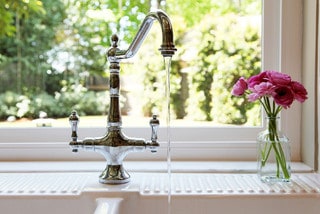Contents
- 1 Best Faucets for Kitchen Sink
- 2 Ceramic valves are better
- 3 Maybe you don’t need a new faucet
- 4 Consider a simpler stopper
- 5 Spend enough, but not too much
- 6 Watch the spout height and reach
- 7 Pull-down sprayers are better
- 8 Count the holes in your sink
- 9 Some finishes are tougher than others
- 10 A single handle is more convenient
Best Faucets for Kitchen Sink
Style matters, but don’t ignore the practical factors
Most people choose a faucet based on looks alone. And that’s a mistake. Style does matter, but you can usually get the look you want without compromising on other things.
Ceramic parts are tiny, but tough. Friction and particles in water slowly destroy other valves, but have no effect on ceramic, which is about five times harder than steel.
Ceramic valves are better
Standard faucet valves usually last for years. But eventually, the rubber parts inside wear— and that means a drippy faucet. Ceramic valves, on the other hand, go drip-free for decades, whether they’re in kitchens, bathrooms, tubs or showers. Faucets with ceramic valves come in a huge variety of styles and cost about the same as those with standard valves.
Maybe you don’t need a new faucet
Years of mineral buildup, especially in crevices, make a faucet look worn out and beyond help. But with a thorough cleaning, most faucets can look as good as new (or almost). Clean with a product that’s formulated to dissolve minerals (CLR is one brand) and scrub with a toothbrush. You’ll be amazed how good your old faucet looks! Warning: Powerful cleaners might damage surrounding surfaces, so be sure to check the label.
Consider a simpler stopper
Most bath faucets come with a stopper for the sink. Most of those stoppers are the standard type found in the vast majority of bathrooms. The trouble with that old, standard design is that the linkages are hard to adjust just right and often need readjustment to open or seal properly. So consider a faucet that comes with an improved stopper. American Standard’s SpeedConnect and Pfister’s Push & Seal are two examples.
Spend enough, but not too much
Plan to spend at least $65 for a bathroom faucet and $100 for a kitchen faucet. You might get a great faucet for less, but it’s more likely that you’ll get low quality. If you spend much more, you’re paying for extra features or style rather than reliability or durability.
Watch the spout height and reach
Faucet spouts vary a lot in height and reach, and most of the time you can just choose the look you like best. But if you have a shelf above the sink, a tall spout may not fit. With a three-bowl kitchen sink, a spout with a short reach may not extend to all the bowls. A bath faucet with a short reach might cause you to slop water behind the spout when you wash your hands.
Pull-down sprayers are better
If you’ve ever had a “side” sprayer (a spray handle mounted in the sink), you’ve probably had dribbles or leaks. And you might assume you’d have similar (and more expensive) trouble with a faucet mounted sprayer like the one shown here. Probably not. All of our experts told us that “pull-down” sprayers have proven much more reliable than the old side sprayers.
Count the holes in your sink
If you want to switch from two handles to one, you have to think about the number of holes in the sink. Most sinks have three holes: one for the hot handle, one for the cold and one under the spout. Some single-handle faucets include a cover plate to hide the extra holes. But some don’t, so check the label. If you currently have a “wide spread” bathroom faucet with two handles far from the spout, you can’t switch to a single-handle model. If you want a kitchen faucet with a pull-down sprayer mounted in the spout, there will be an empty sprayer hole. But the solution is simple: Install a soap dispenser. Your new faucet may even include one.
Some finishes are tougher than others
Choose a finish that matches nearby cabinet hardware, towel bars, etc. Mismatches look bad. The majority of faucets have polished chrome, satin nickel or bronze finishes. All of these finishes are durable and keep their good looks for years. But some are more durable than others. Chrome is the most durable finish and the easiest to keep clean—that’s why it’s always been the favorite for commercial kitchens and public bathrooms. Nickel finishes are usually labeled “brushed,” “satin” or “stainless steel” and have a dull shine. They’re durable but prone to fingerprints and water spots, so they’re harder to keep clean. Some have a coating that reduces stains and smudges, but that coating isn’t as durable as metal. Bronze faucets have a brownish tone and are often called “oiled” or “rubbed” bronze. But the surface is a coating (such as epoxy) rather than metal. This coating is tough stuff, but will chip or scratch more easily than metal.
A single handle is more convenient
Two-handle faucets have a stylish symmetry that suits many bathrooms, especially traditional ones. But in practical terms, single-handle faucets have all the advantages. They’re just plain more convenient; water temperature adjustment is easier and there’s one less handle to clean.
